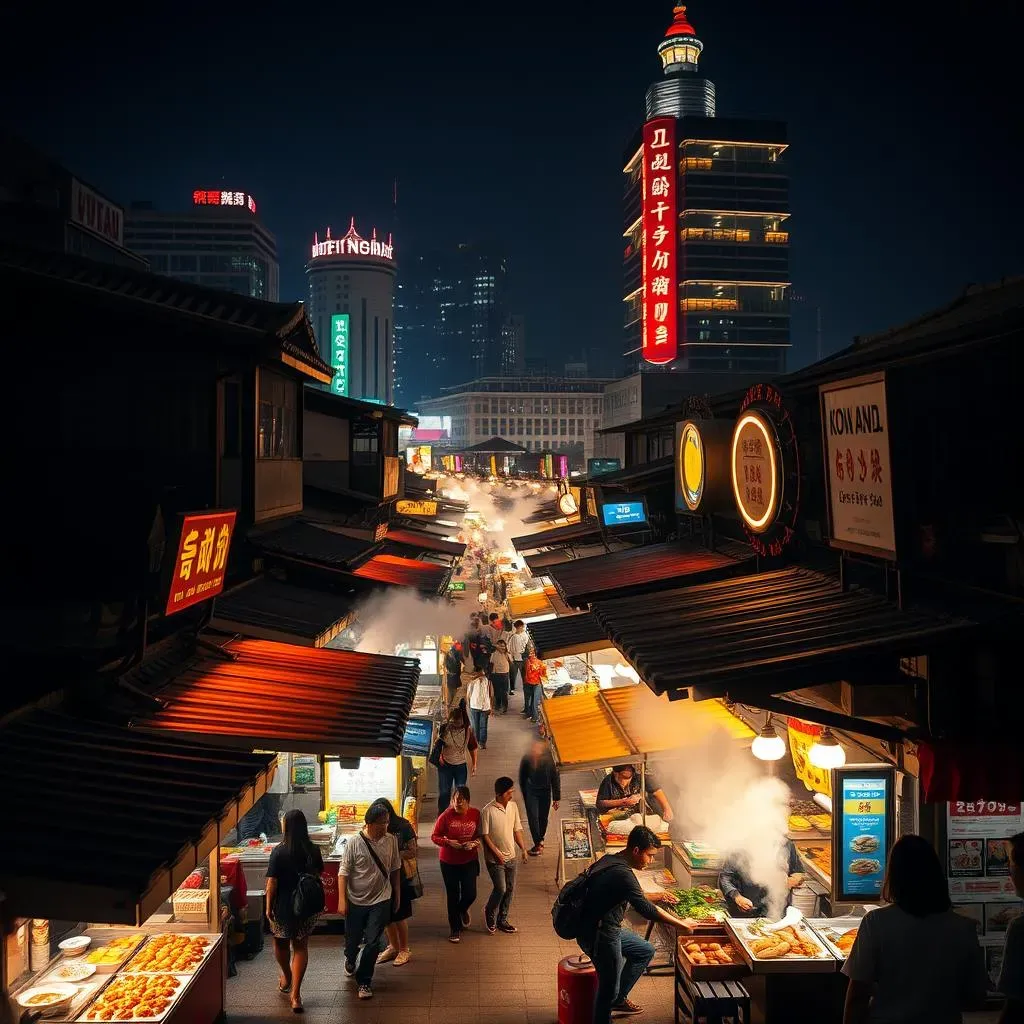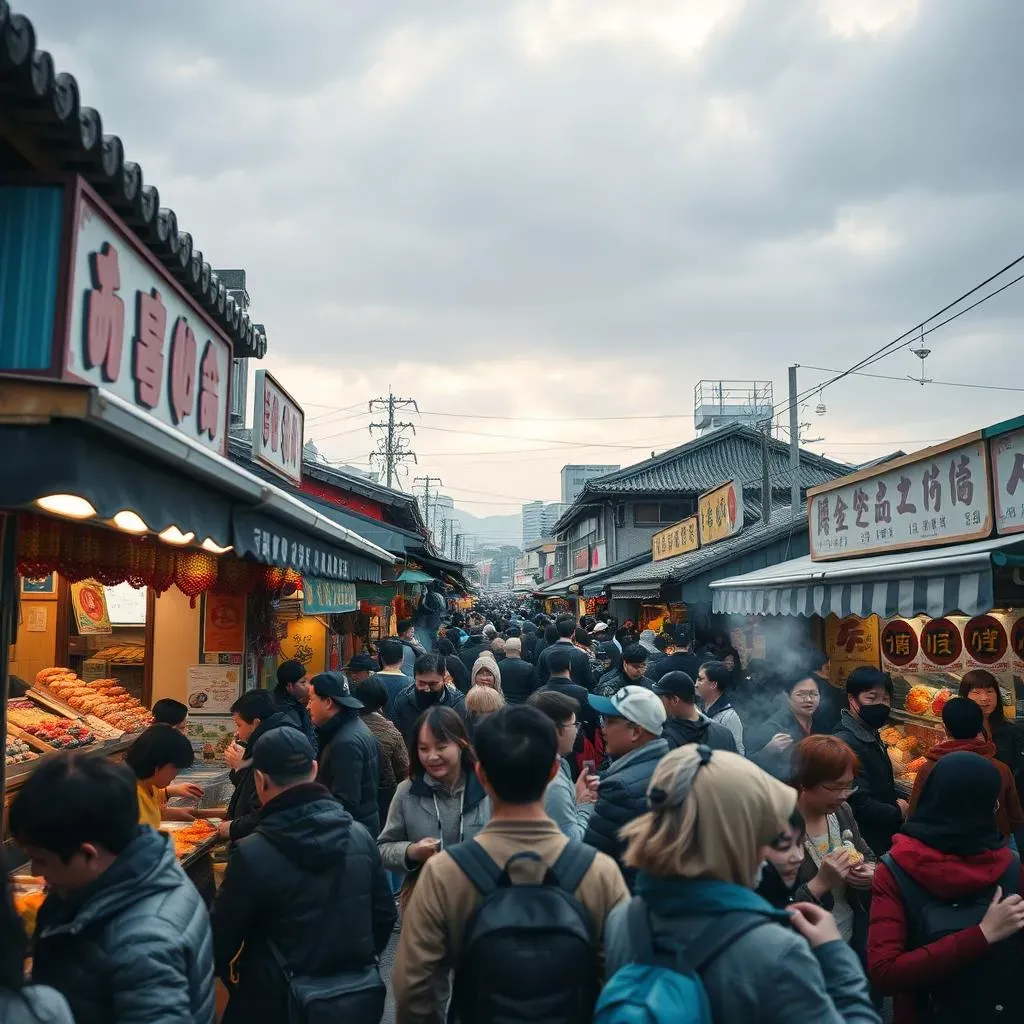Table of Contents
Get ready for a culinary journey through the vibrant streets of Seoul! This article is your ultimate guide to the incredible world of Seoul Korean street food. We'll explore the rich history and cultural significance of this beloved cuisine, taking you beyond the typical tourist traps to discover hidden gems and local favorites. Prepare your taste buds for an adventure as we delve into the must-try dishes, from the spicy kick of tteokbokki to the savory delight of kimbap. We'll uncover the best places to find these delicious treats, from bustling markets to hidden alleyways, and share tips on navigating Seoul's street food scene like a pro. But it's not just about the food; we'll also uncover the unique atmosphere and cultural experiences that make Seoul's street food so special. So, grab your chopsticks and let's embark on this unforgettable exploration of Seoul Korean street food!
Seoul Korean Street Food: A Taste of Tradition
Seoul Korean Street Food: A Taste of Tradition
A Culinary History
Seoul's street food scene isn't just about delicious snacks; it's a living testament to Korea's rich culinary history. For centuries, street vendors have played a vital role in Korean society, offering affordable and tasty meals to everyone from farmers to royalty. Think of them as the original food trucks, adapting and evolving their menus based on seasonal ingredients and changing tastes. This tradition continues today, with each dish carrying a piece of the country's past.
Many popular Seoul Korean street food items have roots stretching back hundreds of years. Tteokbokki, for instance, while now a ubiquitous street food, has a history intertwined with royal court cuisine. The humble origins of other dishes, such as kimbap, reflect the resourceful nature of Korean cuisine, utilizing readily available ingredients to create something delicious and satisfying. Check out our post on Korean street food history for a deeper dive.
Dish | Historical Context | Modern Adaptation |
|---|---|---|
Tteokbokki | Royal court influences | Spicy street food staple |
Kimbap | Simple ingredients, resourceful origins | Versatile snack, countless variations |
The Evolution of Street Food
Over time, Seoul's street food has adapted to reflect the city's rapid growth and globalization. While traditional dishes remain incredibly popular, you'll also find a wave of innovative fusion creations. Imagine a Korean-style taco, or a tteokbokki with a surprising twist of mozzarella cheese! This blend of old and new makes Seoul's street food scene so exciting and dynamic.
The influence of pop culture, particularly K-dramas and K-pop, has also played a significant role in the global popularity of Seoul Korean street food. Shows often feature characters enjoying these tasty treats, introducing them to a worldwide audience and creating a sense of longing for the experience. This cultural impact has boosted the visibility and appeal of these foods beyond Korea's borders. For a visual feast, see our photo gallery of Korean street food.
- Traditional dishes remain popular
- Fusion food combines old and new
- Pop culture boosts global popularity
More Than Just Food
Beyond the delicious flavors, Seoul's street food offers a unique cultural experience. It's a chance to interact with friendly vendors, observe the bustling energy of the city, and soak up the vibrant atmosphere of local markets. It's not just about eating; it's about becoming a part of the daily life of Seoul.
Visiting these street food stalls isn't just about grabbing a quick bite; it's about engaging in a social ritual, a shared experience. Whether you're enjoying a snack with friends, or simply observing the interactions between vendors and customers, you'll find yourself immersed in a truly authentic Korean experience. Learn some basic Korean phrases to enhance your interactions! See our guide on Korean street food vendors.
MustTry Seoul Korean Street Food Dishes and Where to Find Them
MustTry Seoul Korean Street Food Dishes and Where to Find Them
Spicy Sensations: Tteokbokki and More
Let's start with the undisputed queen of Seoul street food: Tteokbokki! These chewy rice cakes simmered in a fiery gochujang sauce are a must-try. The heat level varies from stall to stall, so feel free to ask for a milder version if you're not a spice fiend. You'll find countless tteokbokki vendors throughout the city, but Sindang-dong Tteokbokki Town is legendary for its variety of styles and flavors. Don't be shy to explore different stalls and sample a few variations—it's all part of the fun!
Beyond tteokbokki, Seoul offers a spicy adventure around every corner. Consider trying rabokki, a delicious fusion dish combining ramen and tteokbokki, or try the fiery flavors of ddeokbokki with various protein additions. For a truly unforgettable experience, consider joining a guided street food tour—they often feature unique spicy dishes you might miss otherwise. Many tours also include lesser-known gems that are worth checking out.
- Tteokbokki (various locations)
- Rabokki (various locations)
- Spicy variations (explore different stalls)
Sweet and Savory Delights: Kimbap and Beyond
Now, let's balance the spice with some sweet and savory goodness. Kimbap, often described as Korean sushi, is a ubiquitous and versatile street food. These seaweed-wrapped rolls, filled with rice, vegetables, and sometimes meat or fish, are a perfect grab-and-go snack. Gwangjang Market is a fantastic place to find delicious kimbap, often alongside other street food classics. The market itself is a feast for the senses, a vibrant hub of activity and culinary delights.
But kimbap is just the tip of the iceberg! Explore the many variations of this dish, from the simple and classic to more elaborate and flavorful versions. Other savory snacks to consider include hotteok (sweet pancakes), mandu (dumplings), and the ever-popular Korean corn dogs. For a comprehensive guide to these and other incredible recipes, check out our Korean street food recipes page; you can even try making some at home!
Dish | Description | Where to Find It |
|---|---|---|
Kimbap | Seaweed-wrapped rice rolls | Gwangjang Market and various street vendors |
Hotteok | Sweet pancakes | Many street vendors and markets |
Beyond the Bites: Experiencing Seoul's Street Food Culture
Beyond the Bites: Experiencing Seoul's Street Food Culture
The Atmosphere and Energy
Forget stuffy restaurants; Seoul's street food scene is all about the vibrant energy. Imagine bustling markets filled with the aroma of sizzling meats, the chatter of locals, and the happy chaos of people enjoying delicious treats. The atmosphere is infectious; you can't help but feel swept up in the excitement. It's a sensory overload in the best way possible – a symphony of sights, sounds, and smells.
Each market has its own unique personality. Gwangjang Market, for example, feels historic and traditional, while Myeongdong offers a more modern and trendy vibe. Exploring these different locations is part of the adventure, offering a glimpse into various aspects of Seoul's diverse culture. For a deeper look at different market atmospheres, check out our post on Korean street food markets.
- Bustling markets
- Variety of aromas and sounds
- Unique atmosphere in each location
Social Interactions and Shared Experiences
Seoul's street food isn't just about individual enjoyment; it's a social activity. Many vendors set up their stalls in communal areas, fostering a sense of shared experience. Observe the interactions between vendors and customers – it's often friendly and engaging, creating a welcoming environment for both locals and tourists. You might find yourself chatting with a friendly vendor or striking up a conversation with fellow food lovers.
Sharing food is a big part of Korean culture, and street food perfectly embodies this spirit. Grab some tteokbokki with friends, or share a plate of kimbap with newfound acquaintances. These shared moments create lasting memories, transforming a simple meal into a meaningful cultural exchange. For some tips on making the most of your interactions, take a look at our article on Korean street food vendors.
Interaction Type | Description | Impact |
|---|---|---|
Vendor-Customer | Friendly exchanges, recommendations | Enhances the experience |
Sharing Food | Communal eating, bonding | Creates lasting memories |
Beyond the Food: Cultural Immersion
Eating Seoul Korean street food is more than just satisfying hunger; it's a window into Korean culture. The dishes themselves reflect the country's history and ingredients, while the act of eating on the street provides a glimpse into daily life. Pay attention to the details – the bustling energy of the city, the unique designs of the food stalls, and the way locals interact with the food and each other.
Consider venturing beyond the most popular spots to discover hidden gems and lesser-known culinary treasures. Explore smaller alleyways and local markets to find authentic flavors and unique experiences. You might stumble upon a family-run stall serving a generations-old recipe, or a trendy new spot offering innovative fusion dishes. To help with your exploration, consider a guided food tour which can lead you to some of these hidden gems.